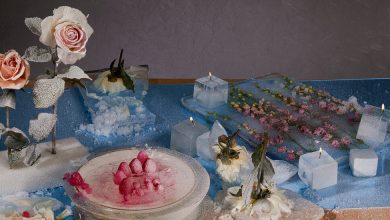The Fiddle Leaf Fig Is Dead

Mike Rimland, the “plant hunter” for Costa Farms, one of the largest houseplant growers in North America, was touring a tiny nursery in Southeast Asia about five years ago when he spotted a bunch of dark purple waxy leaves he didn’t recognize.
“I’d never seen anything like it,” said Mr. Rimland, 66, whose official title is vice president for research and development. He grew up in Miami and has worked in the horticulture business for 45 years.
He spends about four months each year trekking through tropical regions in countries like India, Vietnam and Kenya in search of the “newest, coolest” plants — that will also thrive indoors — to fill the shelves of Ikea, Walmart, Costco and Home Depot, as well as smaller garden centers around the country.
“You’re looking for a needle in a haystack,” Mr. Rimland said.
The plant he saw, the Geogenanthus ciliatus, or Geo, was commercially rare, it looked “like Mars,” he said, with slightly curled, almost black sprouts and had a thick leaf that suggested it would be hard to kill — all the qualities of a hit houseplant.

The Geogenanthus ciliatus recently won the honor of “Best New Foliage” at the Tropical Plant International Expo, a top industry trade show.Credit…Scott McIntyre for The New York Times
Now, after years of development, the Geo has arrived at stores and recently won the coveted honor of “Best New Foliage” at the Tropical Plant International Expo, a top industry trade show. It is on sale at major retailers and small boutiques as far and wide as Brooklyn, Los Angeles and Des Moines and is being marketed with the dollar-sign-eyes of a Timothée Chalamet movie. Online, fans are beginning to gush. (“My little goth baby,” one wrote on Instagram.)
Plant sales for all kinds of varieties have surged over the past few years. About 38 million households in the United States participate in indoor houseplant gardening and spent about $1.67 billion in 2020, an increase of 28 percent from 2019, according to the 2021 National Gardening Survey.
Many enthusiasts, including millennials and Gen Zers, continue to gravitate to rare varieties with a sharper look that often sell for hundreds of dollars in online auctions. Now, mass-market growers like Costa Farms are on a mission to deliver the next “It” plant at a time when new varieties lose their novelty in a matter of months.
“The ‘It’ plant is the quest,” said Katie Dubow, the president of Garden Media Group, a public relations firm that advises companies on market trends. “Everybody wants to have it, grow it, sell it.”
People’s relationships with their plants deepened during the pandemic, industry experts say, and once trendy varieties started to seem dusty. Former “It” plants like the pilea peperomioides, with its coin-shaped leaves, and the fiddle leaf fig, a fixture of home design catalogs, have been bumped out of vogue. (The fiddle leaf “got a bad rap” in part because it is harder to care for than it looks, explained Christian Esguerra, an influencer who posts under the handle “crazyplantguy.”) The raven zz had a moment, the philodendron birkin was coveted briefly, and the pink princess is on its way out.
Now, instead of one plant that everyone wants, dozens are popular. The National Garden Bureau declared 2022 the year of the peperomia, but fans are also craving alocasias, anthuriums, calatheas and hoyas of all kinds.
Variegated monsteras with stripes or blotches of color like the Thai constellation, known for its yellow and white splattered leaves, and the monstera albo, beloved for its white paint-like patches, have remained in demand, in part because certain botanical qualities make them difficult to propagate.
On eBay this month, a five-leaf Thai constellation plant sold for $600 and a five-leaf cutting of a monstera albo went for $500. Costa Farms, which has been trying to grow its own version of the Thai constellation for several years, recently released a limited supply of the plants at Walmart — priced at about $600 each for a 12-inch pot — and sold out quickly. (Proceeds went to charity.)
The look has also evolved. Popular plants now are often variegated with big, highly textured, angular leaves that are frequently pink or purple. And when displayed, instead of a singular statement plant posted in a window, they’re often grouped together in a corner like a jungle or packed into a growing case.
“I think style is a much bigger component of this particular wave of houseplant enthusiasm,” said Leslie F. Halleck, a professional horticulturist and consultant. “That aesthetic of shape and form, and how it plays into someone’s interior space, has become more important.”
Trends are driven, in part, by an avid group of rare plant collectors and influencers who covet specific varieties the way others might seek out sneakers, watches or whiskey, and display their collections with similar pride.
“You grow a big staghorn fern and people come over to your house, and are like, ‘What the heck is that thing?’” said Ryan Benoit, who co-founded the blog The Horticult, adding: “It’s like your kids got accepted to an Ivy League college — they’re doing well.”
There is also, still, a well-established community of buyers who say they connect to their plants emotionally.
Maria Failla, 33, a former Broadway performer, turned to gardening after she lost her job at the start of the pandemic.
“I feel like when I got into plants a part of my heart lit up that I wasn’t even connected with,” said Ms. Failla, who runs a virtual garden society and hosts the podcast “Bloom and Grow Radio.”
The horticulture industry, which has long relied on the spending habits of baby boomers, has perked up at the interest — and money — from a new generation. For years, breeders have released plants with specific qualities that sell well, like maple trees that promise brighter fall foliage. By leaning into unique varieties with unusual leaves, they are applying this approach to houseplants, industry consultants say.
“I don’t just have a hydrangea. I’ve got an endless summer hydrangea. It blooms all summer long,” said Charles Hall, a professor of economics and horticulture at Texas A&M University. “I think the houseplant category in itself is just now catching up to that phenomena.”
For over 40 years, Mr. Rimland has run a nursery in Miami near Costa Farms, and remembers when people went crazy for houseplants in the 1970s. In 1981, he started “plant hunting,” at a time when the market was saturated. Finding and introducing new plants gave him an advantage in the industry, he said. Over the years, he has traveled to about 60 countries.
After a hurricane hit his nursery in 2005, Costa Farms invited Mr. Rimland to work with the company. Over time, he has built relationships with small growers in tropical locations across the globe and continues to search as he always has — with few expectations for what he might find.
“We don’t just need a new plant, we need one that’s different,” he said.
He was vague about exactly where he found the Geo — he didn’t want to tip off the competition. (As interest in plants has exploded, other growers, large and small, are also always in search of new varieties to develop and sell widely.)
Mr. Rimland said he follows all local regulations and searches only in government-approved regions. “I’m not out climbing a mountain stealing plants that are endangered,” he said.
Before leaving Asia, Mr. Rimland shipped several cuttings, roots with a few leaves, to the United States. Costa Farms then began a series of indoor trials to make sure the Geo wouldn’t die easily, turn brown, develop diseases or drop leaves. The company tested them in no light, low light and low humidity environments — the suboptimal growing conditions houseplants must often endure.
“We don’t need to introduce something that’s fluorescent purple but dies in a week,” Mr. Rimland said. “We need customer success.”
Over about four years, the company grew the supply to about 100,000 plants and distributed them to retailers across North America, where a small Geo in a 6-inch pot is selling online for about $45.
“We are not here to supply plants at these crazy prices that you see on the internet,” Mr. Rimland said. “We’re here to supply plants to everybody that wants one at a fair and reasonable price.”
In the coming months, Costa Farms will continue to release new varieties and has teamed with the influencers behind Black Girls With Gardens, Mariah Grows and House Plus Plant, who are expected to do “unboxings” and ceremoniously reveal new plants. Industry experts believe that by constantly feeding the market, growers will keep fans coming back.
Of course, once plants like the Geo are released widely, they are no longer truly rare, said Ms. Dubow, who works in trend forecasting.
“Many people wish there wouldn’t be this huge pressure on ‘What’s the next big ‘It’ plant?’” Ms. Dubow said. “It has this peak where it’s $400, and then Costa gets it, it goes out to all Walmarts and Ikeas and whatever across the country, and so now it’s $19.99 and nobody wants it anymore.”
Conservation groups are also working to raise awareness about the link between the surging interest in rare species and an increase in plant poaching. In South Africa and Chile, authorities say, there has been a rise in succulent and cactus poaching often by people looking for a way to escape poverty.
Abby Meyer, the executive director of Botanic Gardens Conservation International U.S., said the biggest impact has been on biodiversity-rich, tropical zones.
“The demand in collectible tropical plants as houseplants is directly correlated to increased plant poaching in tropical regions,” Ms. Meyer said.
It can also be difficult for shoppers buying plants online through social media sites to know where varieties are coming from and how they are sourced.
Ms. Meyer advised people to seek out licensed nurseries, talk to growers, ask about their sources and research the issues affecting particular varieties. Or, don’t buy them at all, she said, and consider volunteering at botanical gardens that house rare plants instead.
“If you’re interested in orchids and your local garden has an orchid collection,” Ms. Meyer said, “you can get your orchid fix at the garden, and it’s for the public good.”





